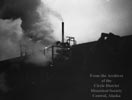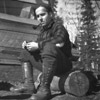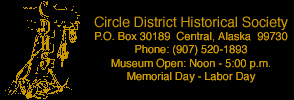
Grip Collection 101-150 Index
Click on a thumbnail
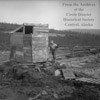
86-P-21-101
The chicksale- with ramp to get across the mud.

86-P-21-102
Roy, who returned to Renton after just one season (1936) and Frank Holma in
front of tent.
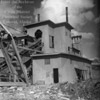
86-P-21-103
View of the dredge.
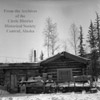
86-P-21-104
George Moore cabin at Happy Station. where Hank and I stayed when we took
out that winter dump.
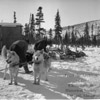
86-P-21-105
Leonard Seppala's team being hitched up by Hank Pagean and another fellow.
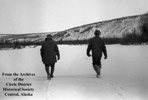
86-P-21-106
Leonard Sepalla, on left and Hank Pagean on right, near Happy Station.
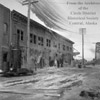
86-P-21-107
When we were in Fairbanks, I think in the winter of 1940, there was a dandy
fire at First and Cushman. The wood buildings, ice on the streets, ice on
the poles--fire fighting in cold weather is no easy thing.
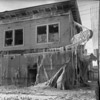
86-P-21-108
Red Cross Drug Store fire, First and Cushman, Fairbanks, probably winter of
1940.
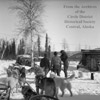
86-P-21-109
Happy Creek, near Happy Station. Sepalla's team, with Sepalla on left, Hank
Pagean in center, and commercial photographer Dick Hylan on right. He had
his studio over Red Cross Drug in Fairbanks and came from Bellingham. He was
a tall fellow with an old camera, a Folmer Graphlex, probably the original
reflex camera. They were a great camera, but heavy and bulky to handle.
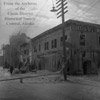
86-P-21-110
Another view of the fire on First Avenue. Federal Building in background.
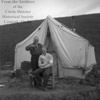
86-P-21-111
Bill Grip getting a haircut; Sid Bernier, barber, at Berry Camp
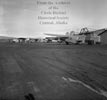
86-P-21-112
Wien planes at Weeks Field, Fairbanks, in springtime--time to return to Circle
District for work.
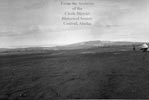
86-P-21-113
View of airfield and plane at Fairbanks.
86-P-21-114
First snow hits the Berry Dredge Camp on Mammoth Creek in the autumn, late
1930s, highlighting the wood-burning dredge and the point field.
86-P-21-115
Dredge, with wood scow at right of pond and pole, so that scow can be poled
over to dredge. In this rear view of dredge, you can see stacker and the spud
is down and water coming off the sluice boxes.
86-P-21-116
View of dredge and camp from hillside.

86-P-21-117
Don Curlin, with dredge in background.

86-P-21-118
The tent in which Hank Pagean and I lived at dredge camp. We must have had
our hands pretty clean by the time we got this far, as the entry isn't too
dirty. We used a coffee can for the stove safety.
86-P-21-119
An excellent photo of the Berry Camp in the late 1930s, showing water pipeline
from hillside ditch, tripods, possibly from the Circle Telephone line down
into Berry Camp, the dredge camp, vehicles of the era, tailings piles, dredge
in operation and thawed field ahead. Although the copy print is somewhat scratchy,
it is a valuable historical photo because of of the clear overall view of
the camp operation.

86-P-21-120
Oscar Utgaard, the dredge master, and Stan Gibson, to Utgaard's right, winchman,
looking at the broken shaft.

86-P-21-121
Long view of dredge.
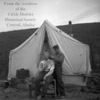
86-P-21-122
Hank Pagean, giving Bill Grip a haircut. "And on the left is our fine
bathtub--sometimes called a plain old washtub. We used it to wash our clothes
as well."

86-P-21-123
The RV-8 from Archie Llaird's Mastodon Operation, moving water pump unit.
86-P-21-124
Dredge behind a tailing pile.
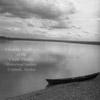
86-P-21-125
At Circle City, with the Yukon river and a canoe. Probably on July 4, the
miners' holiday.
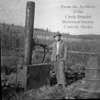
86-P-21-126
Lee Rebail at the boiler, in his tin pants and coat, but usual old Fedora.
86-P-21-127
Hank Pagean and Leonard Sepalla on Happy Creek with dog team.
86-P-21-128
Tent camp at dredge camp, 1936, before new cabins were built.
86-P-21-129
Episcopal Church interior at Circle City, late 1930s.
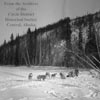
86-P-21-130
Sepalla's team at Happy Creek. " was always proud that I had the association
with somebody that knew something about dogs."
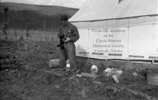
86-P-21-131
Hank Pagean with his Kodak Medalist. "We have a bit of firewood here,
because it was early October and we had to break the ice in order to wash
our faces, It was cold."
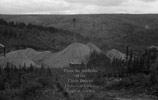
86-P-21-132
A dragline operation in the Circle District, but not at Berry Camp.
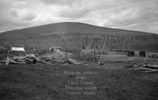
86-P-21-133
Laying the keel for the new dredge hull in 1936. The dredge had been closed
down for several years, due to low gold price and high labor costs, near lower
Mastodon. In 1936, it was relocated on a new hull on Mammoth Creek, below
Miller House. Large machinery pieces were moved during winter of 1935-6 and
pumps were moved by Ford flatbed truck (in CDHS collection), driven by Dan
Bergevin, who--in 1985--coordinated the move of much of this same equipment
from Mammoth Creek to the CDHS museum yard.
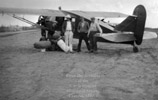
86-P-21-134
"Can't identify first from left or second from left, but third is Steve
Rideout and the fourth may be Warren Johns. Bellanca aircraft, Pollock's Flying
Service."
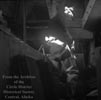
86-P-21-135
Harold Christensen in sluice box getting ready for a cleanup.
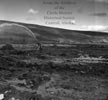
86-P-21-136
View of giant, with camp in background.
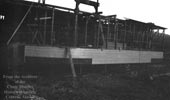
86-P-21-137
Dredge under construction.
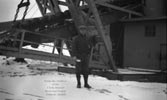
86-P-21-138
Stanley Gibson, standing on the ice with the dredge locked in. The crew is
getting ready to cut blocks of ice for the icehouse during the summer.
86-P-21-139
Dredge fire, autumn, 1938.
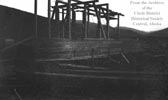
86-P-21-140
Dredge under construction, 1936.
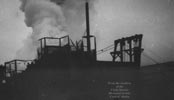
86-P-21-141
Apparently early stage of dredge fire, 1938.
86-P-21-143
Dredge fire, with a lot of smoke and steam.
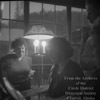
86-P-21-144
Four people enjoying music at Circle Hot Springs. Left, Joy Frasca, Charlotte
Wehner at piano, Chuck Gibson and unidentified shoulder. Late 1930s.
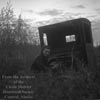
86-P-21-145
This is the girl that Don Curlin married, with an old 1920s truck body.
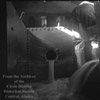
86-P-21-146
Pair of hip boots, standing by sluice box.
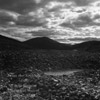
86-P-21-148
View of the tailings and Mammoth Creek, with dredge and giant in center left.

86-P-21-149
Verla Christensen and son Leonard, at Circle Hot Springs, late 1930s.
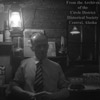
86-P-21-150
Harry Johnson at Circle Hot Springs. 1939-41. In old bar.
